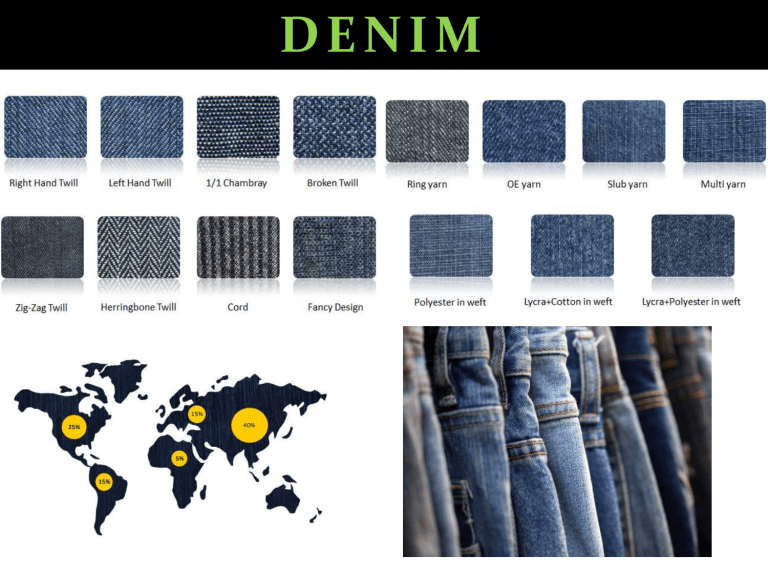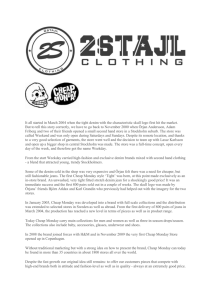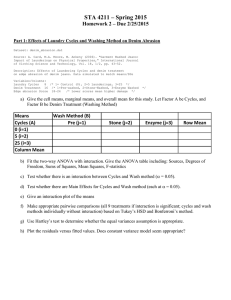Denim Fabric: Manufacturing, Types & Bangladesh Prospects
advertisement

DENIM PREPARED BY ©right Name : MAZADUL HASAN SHESHIR ID: 2010000400008 Batch: 13th Batch (Session 2009-2013) Department: Wet Processing Technology Email: mazadulhasan@yahoo.com Blog: www. Textilelab.blogspot.com Southeast University Department of Textile Engineering Introduction : Denim is a rugged cotton twill textile, in which the weft passes under two or more warp threads. Denim is the most popular pieces of clothing in the world. In 1969 a writer for American Fabrics magazine declared, "Denim is one of the world's oldest fabrics, yet it remains eternally young.“ Denim was invented in California by Levi Strauss in the 1850s. Denim is designed most of the famous USA brand and 400 pieces thousand per month. Now a day’s 415 million pieces of jeans/ Denim sold every year in USA alone and worldwide in denim market is worth amount of 40 billion dollars. Introduction : Denim's popularity was also on the rise. It was stronger and more expensive. Denim was made of one colored thread and one white thread. The countries over 20 denim plants, installed during the last five to six years, have the capacity to produce 20 million gauge fabrics per month. Denims are hard wearing, high density fabric with a higher mass per unit area. At least 225 pair of denim jeans can be made from one bale of cotton. Denim is made from 48% of the world's cotton. Denim fabric was unique in its connection with one color - blue. Types of Denim : Stretch denim Bull Denim Slub denim Printed Denim Ring Denim Poly-Denim Types of Denim Stretch denim: Elastomeric yarn is used in weft. Poly-Denim: Polyester yarn is used in weft. Ring Denim: 7,9,12 count of yarn is used. Bull Denim : A heavy weight denim weave (14oz. Plus) Printed Denim : That has been printed with a pattern-a batik, stripe or floral. Slub denim: Slub yarn is used in warp or weft or in both(Cross Hatch Denim). Manufacturing Process: Spinning: The initial processes of denim manufacturing consist of the regular activities of opening and mixing or blending of cotton fibers. Carding is done to remove any foreign materials and the short fibers. Drawing process produces a single, uniform sliver from a number of carded slivers. Yarn is then spun through Open-End Spinning or Ring Spinning. Quality criteria: Minimum staple length – 2.7 cm Proportion of short fibers(<less then 12 mm long) :under 40% Micronaire value – 4.0 to 4.5 Twist Factor – 4.5 to 5.0(for warp), 4.2(for weft) Count range: Warp 50-90 tex & weft 75-120 tex. low yarn hairiness Yarn strength & uniformity. Warp Preparation - Dyeing and Sizing Processes: Warp yarns are indigo dyed and sized with the help of some methods: Indigo Rope dyeing: There are some stages in indigo rope dyeing. They are: 1.Ball warping. 2.Dyeing. 3. drying. 4.Rebeaming. 5.beaming. 6.Sizing Indigo sheet dyeing: Threads from several back beams are combined to form a warp sheet and dyed then sized on the same machine Indigo loop dyeing: The yarn is dyed in a single bath instead of several. The desired depth of colour is attained by passing the yarn through the vat several times then sized on the same machine. Size recipe for 100 liters of liquor: -8.00 Kg modified starch. -4.00 kg acrylate size. -0.2 kg textile wax. -Size concentration: 8% -Size temperature 850C. -Squeezing pressure: approx.15 KN. -Size pickup: 9% - 10% Weaving & Desizing The weaving process interlaces the warp, which are the length-wise indigo dyed yarn and the filling, which are white in color. Airjet, Rapier, or a Projectile weaving m/c used. Weight range: (6 oz/yd2) to (14 oz/ yd2) Finishing The final woven fabric, wound on a cloth roll. The woven Denim Fabrics then goes through various finishing processes, such as singeing, washing, brushing, drying. Denim Fabric Treatments There are many fabric treatments, and each treatment gives the denim a unique and fashionable look: Stone-washed: In traditional washing process, volcanic rocks or pumice stones are added to the garments during washing Laser technology: It is a computer controlled process for denim fading Spray techniques: This technique is based on spraying the chemicals or pigments to get different effect Sandblasted: Denim is sprayed with sand or chemicals during the wash process to create a worn-out appearance. Denim bleaching: In this process, a strong oxidative bleaching agent such as sodium hypochlorite or KMnO4 is added during the washing Vintage/Dirty: Dirty denim is usually created with brown filler yarns. Diversification of Denim By using Slub/fancy Yarn. By changing EPI & PPI. By using different count. Spandex(Lycra) can be used. By applying different wash effect. (Stone, Enzyme, Blech) By applying different mechanical effect. (Rubbing, brushing) Prospect of Denim in Bangladesh: Bangladesh Export of Denim Jeans to EU: Bangladesh is a major exporter of denim jeans to EU. Being low priced and with special and indefinite duty free and quota free access under ‘Everything but arms’ initiative to EU, Bangladesh continues to dominate the EU denim import business. Currently, it has about 19% share of the denim jeans import market in EU 27 countries. Let’s have a look at the figures of imports of denim from Bangladesh for the last 10 years. Prospect of Denim in Bangladesh Table: Imports of denim from Bangladesh for the last 10 years Different denim factory in Bangladesh: Sinha Denim Ltd. Ha-Meem Denim Mills Ltd. BEXIMCO Royal Denim: Zulekha Denims Ltd Siatex BIG X ENTERPRISES AND ASSOCIATE BONAMI FASHION Toptex Design Ltd. Trendz Group etc Some denim products by Bangladesh: Common Defects of Denim Sewing in BANGLADESH: 1. STITCHES – NEEDLE CUTBROKENTING Where the thread is being broken where one seam crosses another seam (ex: bartacks on top of waistband stitching, seat seam on top of riser seam) resulting in stitch failure. 2. Broken Stitch – Abrasion: Where the thread is broken during stone-washing, sand blasting, hand sanding, etc. Broken stitches must be repaired by restitching over the top of the stitch-line. Common Defects of Denim Sewing in BANGLADESH: 3. Broken Stitches: Chemical Degradation: Where thread is being compromised by the chemicals used during laundering resulting in loss or change of color and seam failure. 4. Unraveling Seams: where either the stitch has been broken or a skipped stitch has occurred. This will cause seam failure unless the seam is Re-stitched. Common Defects of Denim Sewing in BANGLADESH: 5. Ropy Hem: Where hem is not laying flat and is skewed in ROPY HEM appearance. 6. Ragged – Inconsistent Edge: Where the edge of the seam is either extremely "ragged" or "rolls" inside the stitch Common Defects of Denim Sewing in BANGLADESH: 7. Wavy Seams on Stretch Denim: Where the seam does not lay flat and is wavy due to the fabric stretching as it was sewn or during subsequent laundering and handling operation. 8. Twisted Legs: Where the side seam twists around to the front of the pant and distorts the appearance of the jeans. End use: Men’s shirt Bottom wear Critical cargo HI-FASHION DENIM Jeans Wrinkle Free fabric Laser finish Dress Pants Capri pants denim skirts Hats Jackets Overalls Shirts Booties & shoes Shorts Sofa covers Bean bag chairs Director-style chairs Lampshades College Bags Travel Bags Car Seat Covers Denim Curtains Denim Body Suit Denim Face Mask etc




